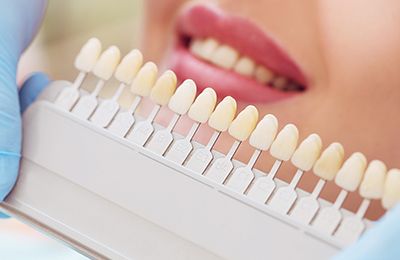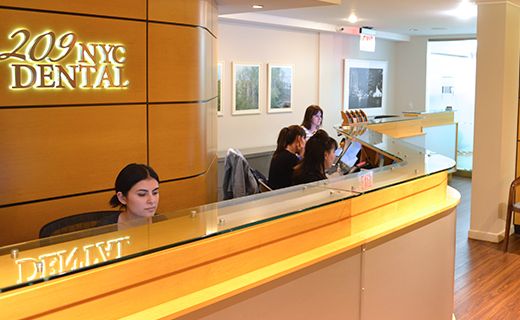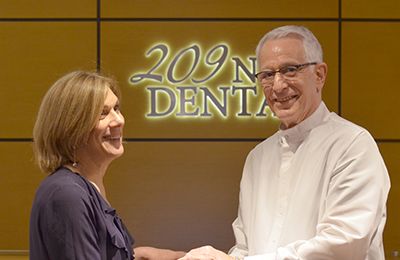Clear Correct vs. Invisalign

Clear aligners enable adults and teens to straighten their teeth without needing traditional wires and bands. Multiple companies produce clear aligners today, and knowing the differences between them will help you determine which to choose.
At 209 NYC Dental, we’re committed to helping you find the best solution for your situation. Dr. Sang (Ben) Ahn is a Diamond Plus Invisalign provider who can start you on the road toward a straighter, more confident smile. We invite you to call us to see if clear aligners are right for you.
- Invisalign Overview
- Invisalign Treatment Options
- Clear Correct Braces Overview
- Clear Correct Treatment Options
- Clear Correct vs. Invisalign
- Who Is an Ideal Candidate for Invisible Braces?
- Clear Braces — Before and After
- Is Invisalign the Best Option?
Clear Correct Aligners vs. Invisalign: Which Is a Better Option?
Orthodontic treatment has seen many positive developments in the recent decade. Gone are the days when the only option to straighten your teeth was traditional metal braces. Today, you have several options for clear plastic aligner trays that move your teeth, including brands such as Invisalign, Clear Correct and the Smile Direct Club. However, you still want to make sure you choose the right option for your treatment plan. There is a lot of information about Clear Correct versus Invisalign and how their clear aligners differ.
Another recent change to orthodontic treatment is how many more adults choose it. Currently, adult patients account for as many as one-quarter of all orthodontic procedures. The convenience and discretion of clear aligners may be partially responsible for the trend of adults seeking more orthodontic treatments more than they had in previous years. Another reason could be that cultural norms are influencing more adults to pursue healthy, confident smiles.
When surveyed,
almost 80% of adults who have straightened their teeth stated that it was one of the most valuable transformations they have ever done. Over 90% of adult patients said that their confidence was positively impacted by having straight teeth, while about 75% said that straightening their teeth had some positive benefits.
If you are considering getting clear aligners to straighten your teeth or correct your bite, many options are available. Take a look at these two clear aligner options, Invisalign and Clear Correct, and see which one could work for you.
Invisalign Overview
When you get Invisalign braces, you will be fitted with clear plastic aligners over your top and bottom teeth. The aligners gradually shift your teeth to straighten them. The aligners differ from traditional braces because you need to remove them before you eat or before you drink any non-clear liquid.
Treatment plans typically call for you to wear your clear aligners for 22 hours every day, using each set for intervals of five to seven days based on your dentist’s evaluation of your tooth movement. After that, you switch to a new set of aligners. Although treatment time frames can vary, patients usually wear their aligners for six to 12 months on average.

Invisalign trays are manufactured by Align Technology. These clear aligners are FDA-approved. They are made of BPA- and BPS-free plastic that does not contain gluten or latex. This material is called SmartTrack®. It is made exclusively for use in Invisalign aligners, and it is thin and flexible. SmartTrack® is known to provide a more secure and comfortable fit compared to other types of aligner materials.
Invisalign treatment always starts with a consultation with an Invisalign certified dentist. A dentist who provides it does not have to be an orthodontist, but they have to be a registered Invisalign provider and a licensed dentist. The dentist has to pass a comprehensive Invisalign training course and has treated patients with the aligners. The provider’s status is then determined by experience and the number of patients the dentist has treated with their clear aligners, i.e., VIP, silver, platinum, diamond and plus.
During the consultation, the provider will review your bite, explain the process. The doctor will propose a treatment plan. The treatment plan will detail how your smile will change while you wear the aligners. You will also find out how long the treatment process will take and how much a particular Invisalign option will cost.
Is Invisalign the Best Clear Aligner? The Benefits
Invisalign is one of the most prominent types of clear aligner trays for good reason. Here are some of the advantages of choosing Invisalign:
- Invisalign is inconspicuous: The clear trays let your natural smile shine.
- Invisalign is removable: You can remove your Invisalign trays to enjoy your favorite foods and drinks.
- Invisalign is comfortable: Invisalign trays stop at the gums for mouth comfort.
- Invisalign is durable: Invisalign trays feature resilient plastic.
- Invisalign is reliable: Invisalign has a long and successful history as a top aligner tray brand.
- Invisalign works: Invisalign treats numerous types of bites, earning favorable reviews from past patients.
For more on the benefits of Invisalign, contact 209 NYC Dental to speak with our Diamond Plus Invisalign provider, Dr. Ahn.
Invisalign Treatment Options
Invisalign treatment includes:
- Invisalign Full: Full Invisalign treatment is the most common treatment option that delivers excellent results and focuses on treating the entire mouth. It includes unlimited aligners and is meant to correct malocclusions ranging from mild to severe. These malocclusions might involve gaps, crowding, an open bite, a crossbite, an overbite or some combination of these issues.
- Invisalign Lite: Invisalign Lite offers a shorter treatment option suitable for mild malocclusion cases. It includes up to 14 aligners.
- Invisalign Express 10: This is a more affordable option for less complicated ortho treatments. It is appropriate for lesser malocclusion issues like crowding and spacing and may be helpful as a primary treatment to restorative or cosmetic procedures. Invisalign Express 10 includes up to 10 sets of aligners.
- Invisalign Express 5, Invisalign i7: This is the least expensive Invisalign option meant for very minor crowding and spacing issues. Express 5 provides up to five sets of trays. Invisalign i7 offers up to seven aligners.
Many people see their provider every six to eight weeks or so for checkups. Patients who have questions or concerns between checkups are encouraged to call their doctor to discuss their concerns.
After completing treatment, patients are strongly advised to wear a retainer to maintain their teeth alignment. Align Tech also produces a line of retainers called Vivera Retainers. They are made of the same material as the clear aligners. Other retainers are available but tend to be made from less durable materials, such as acrylic.
Clear Correct Braces Overview
Clear Correct has many things in common with Invisalign. It is a method of straightening the teeth that involves wearing a clear plastic aligner for a set period. Usually, a person will need to wear the Clear Correct aligners for at least 22 hours a day. The Clear Correct trays are also transparent.

Clear Correct invisible braces require a periodic change of the clear aligners. How frequently a person needs to replace the aligner and how many aligners they end up needing during the treatment depend on the severity of the problem and the type of treatment a person chooses.
The treatment setups with Clear Correct are similar to Invisalign. They start with a consultation with the Clear Correct provider. When determining how long Clear Correct takes, that will depend on the treatment option and your needs, though most patients require at least a year to see results.
Clear Correct Treatment Options
Clear Correct has three treatment options:
- Clear Correct Limited 6 treatment: The Limited 6 treatment option provides a patient with six sets of Clear Correct aligners. Typically, Limited 6 is offered to correct a minor alignment issue.
- Clear Correct Limited 12 treatment: With the Limited 12 plan, a patient gets 12 sets of aligners.
- Clear Correct Unlimited: The unlimited plan provides a patient with as many aligners as needed to correct the issue fully. Patients with severe malocclusion issues will get the best Clear Correct results with this option. This plan also costs the most of the options.
Clear Correct vs. Invisalign
Although Invisalign and Clear Correct are both clear plastic aligners designed to move teeth, they are not identical. There are several crucial differences between the two. Understanding the differences between Clear Correct braces and Invisalign can help you make your decision.
1. Price
The top perceived advantage between Invisalign and Clear Correct is the cost. Clear Correct’s price is advertised to start at $2,000, while the Invisalign price is typically known to start at $5,000 or more. Clear Correct may seem like the more budget-friendly pricing option compared to Invisalign, but you should compare the two and the price ranges of each:
- Clear Correct Cost: The heavily advertised Clear Correct cost of $2,000 typically references the less costly option like Clear Correct Limited 6, which includes six aligners. The price of Clear Correct unlimited treatment will be closer to $4,000 to $5,000 and more in line with the “Invisalign Price.”
- Invisalign Price: The higher price of Invisalign treatment, on the other hand, is referencing Invisalign Full, the unlimited option. Thus, it is worth remembering that you get considerably less with Clear Correct Limited treatment. Read the article Invisalign Cost NYC to learn about the average price of Full Invisalign treatment.
- Clear Correct vs. Invisalign cost: With the recent introduction of Invisalign Express 5, i7, Express 10 and Lite, the different costs of Clear Correct versus Invisalign are no longer relevant. Now, patients have the same orthodontic treatment options at the same price points available through either company.
Depending on which dental insurance you have, there is a possibility that your policy will offer partial coverage for either Invisalign and Clear Correct braces, helping to reduce your out-of-pocket costs. You can also sign up for a payment plan with either Invisalign or Clear Correct, which helps make the clear aligners affordable and accessible.
2. Aligner Thickness
Another difference between Invisalign and Clear Correct braces is the thickness of the aligners. Clear Correct aligners are thinner than Invisalign’s, and the lighter material of Clear Correct may appear to be less visible.
The Clear Correct’s thinner material can also mean that the aligners are not as sturdy or durable as Align Technology aligners and are sharper at the edges. That means they might break more easily, which can interfere with your aligner treatment progress.
3. Comfort in Mouth
The materials used to produce Clear Correct braces and Invisalign aligners are not the same, although they might have been at one point in time. Today, Clear Correct uses a plastic material that Align Technology used many years ago.
Align Technology has since developed its own patented thermoplastic material, SmartTrack®. SmartTrack® was developed after eight years of research and testing nearly 300 different materials. The material makes the aligners easier to take on and off and more gentle and comfortable when worn in the mouth. Additionally, the material is designed to speed up the treatment time and to improve the results you get from Invisalign.
4. Company Experience and Expertise
Align Technology is the older of the two companies by nearly 10 years. The company that produces Invisalign was founded back in 1997, and its aligners were approved by the Food and Drug Administration (FDA) in 1998. By 2001, it had produced around one million aligners. Meanwhile, Clear Correct was founded near the end of 2006 and received approval from the FDA in 2009.
Align Technology has been around longer than Clear Correct, and it has also developed and patented more processes than its competitors, which helps give it an edge and advantage when it comes to expertise. The company holds several hundred patents that cover the material used in its aligners and the processes providers use to map out patients’ teeth and put together a treatment plan that will offer the best overall improvement.

5. Aligner Build
Invisalign uses computerized models of a patient’s teeth and 3D printing technology to create their aligners. This process results in a set of aligner trays calculated to fit the patient’s teeth. The aligners are clear but made of thick material for holding your teeth securely in place. They fit accurately and work reliably well.
Clear Correct also scans the patient’s mouth and uses a 3D printer to create the models. This quick and simple technique has largely replaced the older method of making molds of a patient’s teeth. The aligners are then manually cut to fit over your teeth.
Clear Correct aligners are slimmer than Invisalign, making them less noticeable, and they are created without relying on the same advanced algorithm that Invisalign uses to calculate the progression path of your teeth. Because of this, Clear Correct aligners are slightly less accurate in their fit and in adapting to tooth movements that the aligners are designed to encourage.
Who Is an Ideal Candidate for Invisible Braces?

For the most part,
almost any adult with an issue with the alignment of their teeth or bite can be a good candidate for invisible braces. Invisalign and Clear Correct can both fix the same problems with the bite or alignment of the teeth. A few of the particular problems that invisible braces can help correct include:
- Overbite
- Crowding
- Gaps and spaces
- Crossbite
- Open bite
Clear Braces — Before and After
If you live with minor tooth or jaw misalignment, invisible braces can make a difference.
Overbite: When a person has an overbite, the top front teeth overlap the front lower teeth. Most people have some amount of overbite, and it is not a problem. An overbite can become an issue when it is severe, and the top teeth are too far forward over the bottom teeth. If that is the case, a person can experience discomfort in the jaw. The teeth can also become worn because of an uneven bite pattern. Invisible braces help to move the top teeth back, correcting an overbite. Your dentist will prepare trays that apply pressure inward to gradually push your upper jaw backward. Each new tray will move your jaw closer to a more ideal position than the last.
Crowding: Sometimes, a person’s jaw might be too small for all of the permanent teeth to fit correctly. Crowded teeth can overlap each other, twist to one side or another or be pushed towards the front of the mouth or the back. Maintaining proper oral hygiene can be difficult when teeth are twisted or too close together. Brushing and flossing may not be sufficient to eliminate the bacteria between teeth, which increases the risk of dental decay or gum disease. Clear aligners can help correct crowding by realigning the teeth. Your trays will urge your teeth away from each other. By the time you complete your treatment, your once-crowded smile should fall into a uniform position.
Gaps and Spaces: In some cases, people have space between their teeth, creating a small gap between them. Food can get stuck in these gaps. Some people also feel self-conscious about having spaces between their teeth. Invisible braces help correct spaces and gaps between the teeth by gently pushing the teeth closer together. You’ll wear a tray representing a slightly tighter version of your current smile. The tray will coax your teeth a bit closer together until you move to a new tray even closer to your end goal.

Crossbite:
In the properly aligned mouth, upper teeth cover the lower teeth. A crossbite is when some of the lower teeth cover some of the upper teeth. A crossbite can cause excessive wear on the teeth and even lead to chipping or breakage of the teeth over time. It can also contribute to receding gums, which can increase the risk of gum disease.
Under the treatment of an experienced doctor, Invisible braces can be used to help correct some types of crossbite by repositioning the affected teeth. Gentle pressure from the aligner tray will move all your teeth, creating space for crooked teeth to go and then moving them into a healthy position.

Open Bite: When a person closes their jaw and part of the upper and lower teeth do not come into contact, they have an open bite. An open bite can make it difficult to chew. It can also affect a person’s speech and self-esteem.
Clear braces can help correct some types of an open bite under the supervision of the expert provider. Over time, the invisible braces will push your top teeth downward and inward while pushing upward on your bottom teeth. The process will align your jaw so that your teeth close together while in a resting position.

Is Invisalign the Best Option?
Which clear aligner is right for you — Invisalign or Clear Correct? For several reasons, Align Technology comes out on top. They were the first ones to develop and introduce clear aligners to treat misaligned teeth. The company has been working on developing and improving its aligners for the past couple of decades and now offers one of the most comfortable materials available. The patented material used in Invisalign aligners helps to shorten the treatment by as much as 50%. Since the procedure was introduced, more than 14 million people have corrected their teeth with Invisalign.
Schedule a Free Consultation to See if Invisalign Is Right for You
At 209 NYC Dental, Dr. Sang (Ben) Ahn is a Platinum VIP Invisalign dentist. He provides Invisalign treatment and completes hundreds of cases annually. Dr. Ahn is a highly skilled diagnostician with over 15 years of experience. He is also a master in creating a proper orthodontic treatment and treating malocclusion with Invisalign. To learn more about Invisalign to see if it is the right treatment for you, contact 209 NYC Dental at 212-355-2290 to schedule a consultation today.
Author: Dr. Benjamin Ahn
 Our History
Our History
 Our Providers
Our Providers
 About Us
About Us
 Blog
Blog
 Contact us
Contact us
 Diagnostic & Preventive
Diagnostic & Preventive
 Implant Dentistry
Implant Dentistry
 Cosmetic Dentistry
Cosmetic Dentistry
 Clear Braces
Clear Braces
 Periodontics
Periodontics
 Patient Forms
Patient Forms
 Payment Information
Payment Information
 Insurance Options
Insurance Options
 CareCredit Dental
CareCredit Dental
 Appointment Policy
Appointment Policy
 Free Consultation
Free Consultation
 Complimentary Teeth Whitening
Complimentary Teeth Whitening
 Teeth Whitening
Teeth Whitening





